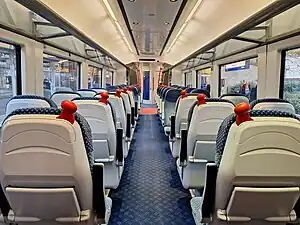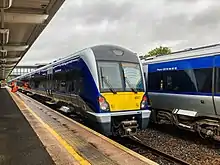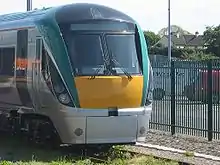NIR Class 4000
The Class 4000 is a type of diesel multiple unit (DMU) in service with Northern Ireland Railways.
| Northern Ireland Railways Class 4000 "C4K" | |
|---|---|
 Class 4000 DMU 4012 at Coleraine railway station, 2021 | |
 Interior view of car 4513 of set 4013 | |
| In service | 2011–present |
| Manufacturer | CAF |
| Family name | CxK |
| Replaced | Class 450 and Class 80 |
| Entered service | 2011–2012 |
| Number built | 20 sets (81 cars in total, 40 DM cars, 41 intermediates) |
| Formation |
|
| Fleet numbers |
|
| Capacity |
|
| Operator(s) | NI Railways |
| Specifications | |
| Maximum speed | 90 mph (145 km/h) |
| Prime mover(s) | MTU 6H 1800 R84[1] (one per car) |
| Engine type | Inline-6 turbo-diesel[2] |
| Displacement | 12.8 L (780 cu in) per engine[2] |
| Power output | 390 kW (520 hp) per engine[2] |
| Transmission |
|
| Safety system(s) | AWS, TPWS |
| Track gauge | 1,600 mm (5 ft 3 in) |

The fleet was procured due to the recognition of the essential role railways play in economic growth and the need to replace outdated rolling stock, particularly Class 80 and Class 450 trains. After receiving funding from the Northern Ireland Assembly and issuing a tender, NI Railways awarded the contract to CAF, which already had a successful track record with the Class 3000 units. The Class 4000 trains entered service in 2011, with significant internal differences from the C3K fleet, such as increased seating capacity and improved fuel economy. The trains have replaced the remaining Class 80 and Class 450 trains, increasing capacity and allowing longer trains to operate. In 2018, 21 additional vehicles were ordered to further extend train lengths. Despite some reported technical issues, testing for six-car formations started in 2021.
History
The fleet covers 20 DMUs procured by NI Railways. None of the Northern Irish rail network is electrified, and diesel multiple units have been used since nationalisation in the 1950s.
Prior to 2000, the NIR rolling stock consisted of a mixture of diesel multiple unit types that had entered service between 15 and 25 years previously. The main type was the Class 80, based on the Mark 2b bodyshell, 22 3-car and 4-car units built in two batches between 1973 and 1979. Additional capacity was provided with the Class 450, nine 3-car units that entered service in 1985 based on the Mark 3 bodyshell. Chronic underinvestment in the railway meant that by the millennium these were the newest domestic trains. By 2000 it was estimated that the network required investment of £183 million to bring it up to basic safety standards.[3]
New trains
Recognising that the railways serve an important role in the growth of the local economy, the devolved Northern Ireland Assembly granted funding for improvements in December 2000 following the report of the Railways Task Force.[4] Included was £80 million for rolling stock, the largest order in the history of NIR. The result was the Class 3000 DMU from CAF in Spain, 23 three-car units used to replace the increasingly outdated Class 80. They entered service between 2004 and 2005. This was a like-for-like replacement meaning that older rolling stock had to be retained, and NIR could not introduce the service enhancements it desired.
"New Trains Two"
The expanding economy led to increasing pressure to improve the rail network, with recommendations made in a debate in the Northern Ireland Assembly in May 2007.[5] Among these was the purchase of rolling stock to replace the remaining Class 80 and Class 450 trains. Translink instituted the "New Trains 2010" (later renamed "New Trains Two") proposal for new trains,[6] and decided that it needed to improve its service frequency to go with the associated infrastructure improvements, which would mean expanding the fleet. The proposal was that up to 20 trains would be purchased, which would replace the Class 450 and 80 units and expand the fleet by up to seven trains. The go-ahead was given on the publication of the draft budget of the Department for Regional Development, which allocated £137 million over three years to Translink, including for 20 trains.[7]
Translink issued the invitation to tender (ITT) in June 2008. Three firm offers were received: Bombardier Transportation offered the Class 172 Turbostar being built for operation on the British network; Hyundai Rotem a variant of the 22000 Class ICR purchased by Iarnród Éireann (ruled out because of NIR's desire to have units with ⅓ and ⅔ spaced doors); and CAF a variant of the Class 3000 units.[8] The similarity with the existing sets led to CAF winning the bid in March 2009.[9] The first train was delivered in March 2011 and after testing it entered service in September 2011.[10][11]
In the summer of 2021, testing began on increased six-car sets using extra intermediate carriages.

 Bombardier Class 172
Bombardier Class 172 Hyundai-Rotem Class 22000
Hyundai-Rotem Class 22000_-_geograph.org.uk_-_1503708.jpg.webp) CAF Class 3000
CAF Class 3000
Timetable
The timetable for the introduction was released at the same time as the ITT:[12][13][10]
- June 2008 - Invitation to Tender
- Wednesday 25 March 2009 - Contracts signed
- June 2010 - Construction of first train begins
- Monday 14 March 2011 - Delivery of first train
- Thursday 29 September 2011 - First train enters passenger service
- Tuesday 3 July 2012 - Final train arrives in Belfast
- Wednesday 19 September 2012 - Final train entered service
- Thursday 6 December 2018 - Order signed with CAF for an additional 21 Class 4000 carriages[14]
Specification
Although the trains are externally similar to the C3K fleet, internally they have significant differences. Each three-car train has a seating capacity of 212,[10] with fewer table bays and extra standing room.[8] They have one toilet compared to the C3K's two.[10] They have a new traction system, with an MTU 390kW engine providing power to both the traction motors and auxiliary generators. With a train being four tonnes lighter than a C3K unit, fuel economy is improved.[8]
Usage
_-_geograph.org.uk_-_2923273.jpg.webp)
The trains have replaced the 13 remaining trains of Class 80 and Class 450. The capacity increase provided has allowed NIR to operate longer trains. Of the seven extra sets, NIR has earmarked five for running in six-car formations, with the other two planned to improve service frequency on the Derry-Londonderry Line once renovation work has been completed and a new crossing loop laid.[8] The option was taken up in December 2018, when 21 additional vehicles were ordered from CAF at a cost of £50 million.[15] The 21 additional vehicles will be used to lengthen seven of the twenty Class 4000 units to six-cars long[16] to provide a train that the conductor can walk through fully, this means only 1 conductor is required. The first three-car set was extended in November 2021, with all six expected to be complete by July 2022.[17]
Technical problems
It has been reported on several websites that at least one train has been taken out of service on several occasions with major engine failure and has been re-engined.
Testing is now underway as of September 2021.
Fleet details
| Class | Operator | No. Built | Year Built | Cars per Set | Unit nos. | In service | Notes |
|---|---|---|---|---|---|---|---|
| Class 4000 | NI Railways | 20 | 2010–2012 | 3 | 4001–4013 | 13 | |
| 6 | 4014–4020 | 7 | New carriages entered service in September 2021[18] |
References
- MTU Rail Power for the UK & Ireland (PDF). MTU Friedrichshafen GmbH. September 2018. p. 2. Archived from the original (PDF) on 3 December 2022. Retrieved 3 December 2022.
- Powerpacks with 6H 1800 for Railcar Applications (PDF) (01/20 ed.). MTU Friedrichshafen GmbH. 20 April 2020. Archived from the original (PDF) on 21 April 2021. Retrieved 30 November 2022.
- Ulster's rusting trains trundle ever more slowly on weed-choked tracks - "The Independent", 06/08/00
- Northern Ireland Railways: Funding for New Trains - Lords Hansard, 10/12/02
- "Northern Ireland Assembly: Development of the Rail Network". Theyworkforyou.com. 14 May 2007. Retrieved 13 September 2010.
- Core Programme: Better Rail Services Archived 6 October 2008 at the Wayback Machine
- "Regional Development Minister welcomes draft Budget allocations". Northernireland.gov.uk. Retrieved 13 September 2010.
- Flanagan, Colm (2010). "Optimism in Northern Ireland". Modern Railways. 67 (737): 60–64.
- Northern Ireland Railways orders CAF DMUs Railway Gazette International 26 March 2009
- "First CAF Class 4000 DMU arrives in Belfast". Railway Gazette International. 14 March 2011.
- Translink’s Invitation to tender for new train order
- "NIR News 167". Irrs.ie. 1 January 2009. Retrieved 13 September 2010.
- Translink Press Release: Production of new Translink trains 'underway'>
- "Press News".
- "Deal done: £50m investment in NI's rail services". newsletter.co.uk. 6 December 2018. Retrieved 23 December 2018.
- Pritchard, Robert (February 2019). "Translink signs contract for 21 new intermediate 4000 Class vehicles". Today's Railways. Platform 5.
- "First longer NIR 4000 Class train in service". Today's Railways. No. 238. Platform 5. December 2021. p. 21.
- https://www.belfastlive.co.uk/news/belfast-news/gallery/translink-take-look-new-longer-21714334
External links
![]() Media related to NIR Class 4000 at Wikimedia Commons
Media related to NIR Class 4000 at Wikimedia Commons